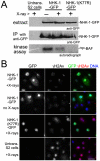The meiotic recombination checkpoint suppresses NHK-1 kinase to prevent reorganisation of the oocyte nucleus in Drosophila
- PMID: 21060809
- PMCID: PMC2965759
- DOI: 10.1371/journal.pgen.1001179
The meiotic recombination checkpoint suppresses NHK-1 kinase to prevent reorganisation of the oocyte nucleus in Drosophila
Abstract
The meiotic recombination checkpoint is a signalling pathway that blocks meiotic progression when the repair of DNA breaks formed during recombination is delayed. In comparison to the signalling pathway itself, however, the molecular targets of the checkpoint that control meiotic progression are not well understood in metazoans. In Drosophila, activation of the meiotic checkpoint is known to prevent formation of the karyosome, a meiosis-specific organisation of chromosomes, but the molecular pathway by which this occurs remains to be identified. Here we show that the conserved kinase NHK-1 (Drosophila Vrk-1) is a crucial meiotic regulator controlled by the meiotic checkpoint. An nhk-1 mutation, whilst resulting in karyosome defects, does so independent of meiotic checkpoint activation. Rather, we find unrepaired DNA breaks formed during recombination suppress NHK-1 activity (inferred from the phosphorylation level of one of its substrates) through the meiotic checkpoint. Additionally DNA breaks induced by X-rays in cultured cells also suppress NHK-1 kinase activity. Unrepaired DNA breaks in oocytes also delay other NHK-1 dependent nuclear events, such as synaptonemal complex disassembly and condensin loading onto chromosomes. Therefore we propose that NHK-1 is a crucial regulator of meiosis and that the meiotic checkpoint suppresses NHK-1 activity to prevent oocyte nuclear reorganisation until DNA breaks are repaired.
Conflict of interest statement
The authors have declared that no competing interests exist.
Figures






Similar articles
-
NHK-1 phosphorylates BAF to allow karyosome formation in the Drosophila oocyte nucleus.J Cell Biol. 2007 Dec 3;179(5):817-24. doi: 10.1083/jcb.200706067. Epub 2007 Nov 26. J Cell Biol. 2007. PMID: 18039935 Free PMC article.
-
Drosophila PCH2 is required for a pachytene checkpoint that monitors double-strand-break-independent events leading to meiotic crossover formation.Genetics. 2009 Jan;181(1):39-51. doi: 10.1534/genetics.108.093112. Epub 2008 Oct 28. Genetics. 2009. PMID: 18957704 Free PMC article.
-
The differential roles of rad9 alternatively spliced forms in double- strand DNA break repair during Drosophila meiosis.DNA Repair (Amst). 2025 May;149:103833. doi: 10.1016/j.dnarep.2025.103833. Epub 2025 Apr 8. DNA Repair (Amst). 2025. PMID: 40250145
-
Histone modifications and the chromatin scaffold for meiotic chromosome architecture.Cell Cycle. 2006 Sep;5(18):2064-71. doi: 10.4161/cc.5.18.3253. Epub 2006 Sep 15. Cell Cycle. 2006. PMID: 16969105 Review.
-
Female Meiosis: Synapsis, Recombination, and Segregation in Drosophila melanogaster.Genetics. 2018 Mar;208(3):875-908. doi: 10.1534/genetics.117.300081. Genetics. 2018. PMID: 29487146 Free PMC article. Review.
Cited by
-
Vaccinia-related kinase 1 (VRK1) is an upstream nucleosomal kinase required for the assembly of 53BP1 foci in response to ionizing radiation-induced DNA damage.J Biol Chem. 2012 Jul 6;287(28):23757-68. doi: 10.1074/jbc.M112.353102. Epub 2012 May 22. J Biol Chem. 2012. PMID: 22621922 Free PMC article.
-
Meiosis: an overview of key differences from mitosis.Cold Spring Harb Perspect Biol. 2015 Jan 20;7(5):a015859. doi: 10.1101/cshperspect.a015859. Cold Spring Harb Perspect Biol. 2015. PMID: 25605710 Free PMC article. Review.
-
Safeguarding genetic information in Drosophila.Chromosoma. 2011 Dec;120(6):547-55. doi: 10.1007/s00412-011-0342-9. Epub 2011 Sep 17. Chromosoma. 2011. PMID: 21927823 Free PMC article. Review.
-
Defective folliculogenesis in female mice lacking Vaccinia-related kinase 1.Sci Rep. 2012;2:468. doi: 10.1038/srep00468. Epub 2012 Jun 25. Sci Rep. 2012. PMID: 22741057 Free PMC article.
-
The meiotic checkpoint network: step-by-step through meiotic prophase.Cold Spring Harb Perspect Biol. 2014 Oct 1;6(10):a016675. doi: 10.1101/cshperspect.a016675. Cold Spring Harb Perspect Biol. 2014. PMID: 25274702 Free PMC article. Review.
References
-
- Keeney S, Giroux CN, Kleckner N. Meiosis-specific DNA double-strand breaks are catalyzed by Spo11, a member of a widely conserved protein family. Cell. 1997;88:375–384. - PubMed
-
- Dernburg AF, McDonald K, Moulder G, Barstead R, Dresser M, et al. Meiotic recombination in C. elegans initiates by a conserved mechanism and is dispensable for homologous chromosome synapsis. Cell. 1998;94:387–398. - PubMed
-
- Keeney S, Baudat F, Angeles M, Zhou ZH, Copeland NG, et al. A mouse homolog of the Saccharomyces cerevisiae meiotic recombination DNA transesterase Spo11p. Genomics. 1999;61:170–182. - PubMed
-
- Page SL, Hawley RS. The genetics and molecular biology of the synaptonemal complex. Annu Rev Cell Dev Biol. 2004;20:525–558. - PubMed
Publication types
MeSH terms
Substances
Grants and funding
LinkOut - more resources
Full Text Sources
Molecular Biology Databases

